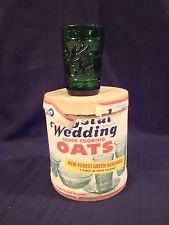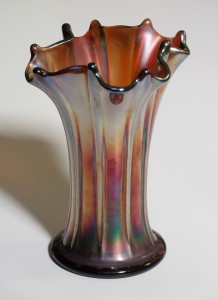How to Identify Depression Glass
Though some identify depression glass as anything produced during the Great Depression, depression glass is actually a distinct type of glass produced during the time. Many types of glass became popular during the Great Depression, as people looked for cheaper ways to decorate their homes without the high cost of crystal or pieces from Tiffany’s. In fact, one type of glass often mistaken for depression glass is carnival glass, and it is referred to as the “Poor Man’s Tiffany.”
Depression glass began its rise to popularity in the roaring 20’s. Companies began to give away pieces as promotional items, so the housewife would purchase the remainder of the set. For example, one could obtain a free piece of depression glass, usually a drinking glass, with each purchase of a can of Crystal Wedding Oats.

A housewife could stop at a gas station for a fill-up and be given another piece of a place setting. Since the pieces were designed primarily as place settings, house wives often ordered the remainder of their set via mail order, if funds allowed. After all, during the hard economic times of the Great Depression, it was helpful to have a jump start on purchasing a new set of dinnerware. “Times were hard,” as many say to this day, and something so simple often gave a glimmer of hope to so many families who struggled to pay for “luxury items.”
Until depression glass and carnival glass emerged, many common people did not have the opportunity to purchase fine dining settings. The promotional idea worked, as the remaining pieces for sale were sold for pennies on the dollar.

Depression glass, in summary, became an affordable way for a housewife to furnish the home without spending much, if any, money.
Some Tips on How to Identify Depression Glass
Because of its quick and mass production techniques, however, depression glass was cheaply made. Though that doesn’t affect its value today, a true piece of depression glass is likely to have imperfections such as raised bubbles, marks from the mould, ripples and even bubbles. It is even common for the glass pieces to differ in their dimensions, appear crooked or even wobble.
During the time depression glass was at its peak, however, it was a reasonable and appealing alternative to crystal, porcelain, china and other fine materials. Some depression glass was even white like porcelain, although most of it was colored. It was produced in colors such as pink, purple, blue, red, yellow, green or amber.
If you are looking for information on how to identify depression glass, the following tips should be helpful:
- Look for imperfections (as described in detail above). Depression glass was cheaply produced and often has inconsistent measurements, bubbles, ripples or other flaws. You should check the rims, however, by running your finger nail across the top. This is where pieces are likely to chip, and it’s easy to mistaken a chip in the glass for a bubble. If you feel a dip or a snag, the piece is likely chipped and won’t be of as much value.
- If the piece appears as part of a place setting and is one solid colour, this is another indication of depression glass.
- Reproductions and modern day replicas are still produced, though they do not hold the same value. If the piece appears perfect, lacking the imperfections described, it is possible it is a replica.
- The best way to identify a specific piece of depression glass is to become familiar with the most common patterns and makers. Because of the nature of production, only some pieces were marked. Though depression glass was produced by dozens of glass companies, there are a few that were the most common, and one can research their patterns in order to more easily identify “mystery pieces.”
- From 1923 to the 1940’s, the following companies were major producers of depression glass: Federal Glass Company, Hazel-Atlas Glass Company, Hocking Glass Company, Indiana Glass Company, Jeanette Glass Company, MacBeth-Evans Glass Company and U.S. Glass.
- If the glass has an iridescent look, it is likely carnival glass and not depression glass.
- The absence or presence of a mark does not indicate authenticity. However, most companies have their markers displayed on their website so that you can identify the timeframe the piece was produced.
What about uranium glass?
Uranium glass refers to a type of process that was applied to both carnival glass and depression glass. Some refer to uranium glass as Vaseline glass, although the two actually differ. Vaseline glass, though similar, is transparent. Uranium glass is opaque. Earlier versions of Vaseline glass were referred to canary glass. Put simply, uranium is used to color Uranium glass, and other additives are used for Vaseline glass. As a general rule, Uranium glass will be a bright, somewhat glowing green when exposed to a black light. This method isn’t fool proof, however, as some glass is reactive due to other chemicals used for coloring. The uranium content of some glass pieces in the 1900’s reached as high as 25%. One can actually be exposed to radiation from some of these pieces, based on the size, content of uranium and the distance it is away from the person. It is not safe to consume food or drinks out of these pieces, and they are best kept simply on display.
Overall, depression glass can be a beautiful addition to an antique collection. The pieces are beautifully displayed at weddings or teas. Cream teas who are lucky enough to adorn these pieces of history are beautiful when paired with other reminders of times past. Though they hold monetary value, many pieces of depression glass represent the hope for better times and finer things more than anything else. It’s very likely you have a grandparent or aunt who has held on to these once prized possessions for many years, or at least remembers having them. Now, you know how to identify depression glass, so you’ll never miss a chance at having something to remind you of the “good ‘ole days.”




